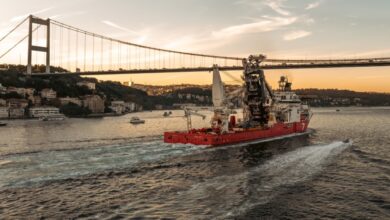ENSCO takes line-of-sight approach to safety
The company then turned its focus to frontline leaders – supervisor, driller, toolpusher, etc – via the Supervisor Safety Training Program (SSTP), which was to continue the line of sight to the company’s SHE vision. The goal of the SSTP, Mr Karish said, is to make a step-change in order to get to a zero-incident workplace. The program is designed to enable ENSCO to attain global consistency and manager/supervisor proficiency through the use of key safety management tools, specifically the Safety Systems of Work (SSOW) and the Dupont STOP program.
Mr Karish noted that about 42 week-long programs will be needed to train about 1,400 employees and the company is currently around the halfway mark for program delivery.
Three service providers were integrated into one team on this project. George Siokos of The Enterprise Development Network, one of the three service providers, was present at the conference to offer preliminary feedback from the SSTP.
First, he noted a disconnect with program participants between assumptions underlying SSOW and STOP, and the reality of what participants actually understood about those safety management tools.
For example, the SSOW assumes that employees understand the tool – that they can recall and know when and how to use it. It also assumes that users understand they can teach SSOW to others.
However, Mr Siokos said, it became clear at the beginning of the program that people didn’t really understand SSOW. For many, it was actually the first time they had seen the program or read it through. At the same time, many would claim that they did understand it, showing a disconnect also between what they believed and the actual realities of SSOW.
Disconnects also existed with STOP, he said. For example, it was found that people had different perceptions about the STOP process and when to submit observation cards. The program assumes that employees have the confidence to use this observation and intervention system, yet many were actually too shy or unable/unwilling to deal with “pushback.”
As the SSTP program progressed, however, people reported gaining confidence to use STOP when confronted by others who pushed back.
Throughout the program, participants are asked to record how they feel and to complete an evaluation sheet after the program. More than 90% reported that the program met their needs, and they also began to fully understand SSOW and STOP, as well as their own roles as leaders.
Related to SSOW, there was pushback over the notion of being “100% right, 100% of the time,” especially early in the program, Mr Siokos said. After the program, they reported seeing that notion at least as a worthwhile vision. They also recognized that SSOW is a reflection of the values of the organization, he said. People also reported understanding for the first time that there are different roles within SSOW and the importance of those roles, he added.
Related to STOP, people began to have a consensus around its underpinning principles. They also realized that it must be continually practiced in order to bring change.
In addition to participants’ feedback, Mr Siokos said that corporate SHE/operations audit teams have provided validation for SSTP.
In the next step of SSTP, supervisors who have attended the program will develop rig-specific action plans and implement them on the rig. These plans will be shared with their rig crews so they can use leadership to create a step-change. Coaching/training to help these supervisors implement the action plans with their rig crews is under consideration, Mr Karish said.




